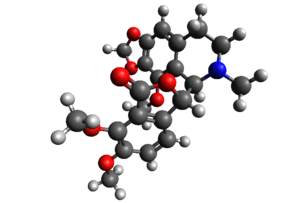Noscapine
 |
|
 |
|
| Systematic (IUPAC) name | |
|---|---|
|
(3S)-6,7-Dimethoxy-3-[(5R)-5,6,7,8-tetrahydro-4-methoxy-6-methyl-1,3-dioxolo(4,5-g)isoquinolin-5-yl]-1(3H)-isobenzofuranone
|
|
| Clinical data | |
| AHFS/Drugs.com | International Drug Names |
| Pregnancy category |
|
| Legal status |
|
| Pharmacokinetic data | |
| Bioavailability | ~30% |
| Biological half-life | 1.5 to 4h (mean 2.5) |
| Identifiers | |
| CAS Number | 128-62-1 |
| ATC code | R05DA07 (WHO) |
| PubChem | CID: 275196 |
| ChemSpider | 242139 |
| UNII | 8V32U4AOQU |
| KEGG | D01036 |
| ChEBI | CHEBI:73237 |
| ChEMBL | CHEMBL364713 |
| Synonyms | Narcotine |
| Chemical data | |
| Formula | C22H23NO7 |
| Molecular mass | 413.421 |
|
|
|
|
| |
|
Noscapine (also known as Narcotine, Nectodon, Nospen, Anarcotine and (archaic) Opiane) is a benzylisoquinoline alkaloid from plants of the poppy family, without painkilling properties. This agent is primarily used for its antitussive (cough-suppressing) effects.
Contents
Medical uses
Noscapine is often used as an antitussive medication.[1] A 2012 Dutch guideline, however, does not recommend its use for coughing.[2]
Side effects
- Loss of coordination
- Hallucinations (auditory and visual)
- Loss of sexual drive
- Swelling of prostate
- Loss of appetite
- Dilated pupils
- Increased heart rate
- Shaking and muscle spasms
- Chest pains
- Increased alertness
- Loss of any sleepiness
- Loss of stereoscopic vision
Interactions
Noscapine can increase the effects of centrally sedating substances such as alcohol and hypnotics.[3]
The drug should not be taken with any MAOIs (monoamine oxidase inhibitors), as unknown and potentially fatal effects may occur.[citation needed]
Noscapine should not be taken in conjunction with warfarin as the anticoagulant effects of warfarin may be increased.[4]
Mechanism of action
Noscapine's antitussive effects appear to be primarily mediated by its σ–receptor agonist activity. Evidence for this mechanism is suggested by experimental evidence in rats. Pretreatment with rimcazole, a σ- specific antagonist, causes a dose-dependent reduction in antitussive activity of noscapine.[5]
Structure analysis
The lactone ring is unstable and opens in basic media. The opposite reaction is presented in acidic media. The bond C1-C3' is also unstable. This is the bond connecting the two optically active carbon atoms. In aqueous solution of sulfuric acid and heating it dissociates into cotarnine (4-methoxy-6-methyl-5,6,7,8-tetrahydro-[1,3]dioxolo[4,5-g]isoquinoline) and opic acid (6-formyl-2,3-dimethoxybenzoic acid). When noscapine is reduced with zinc/HCl, the bond C1-C3' saturates and the molecule dissociates into hydrocotarnine (2-hydroxycotarnine) and meconine (6,7-dimethoxyisobenzofuran-1(3H)-one).
History
Noscapine was first isolated and characterized in chemical breakdown and properties in 1817 under the denomination of "Narcotine"[6] by Pierre Robiquet, a French chemist in Paris. Robiquet conducted over 20 years between 1815 and 1835 a series of studies in the enhancement of methods for the isolation of morphine, and also isolated in 1832 another very important component of raw opium, that he called codeine, currently a widely used opium-derived compound.
Society and culture
Recreational use
There are anecdotal reports of the recreational use of over-the-counter drugs in several countries, being readily available from local pharmacies without a prescription. The effects, beginning around 45 to 120 mins after consumption, are similar to dextromethorphan and alcohol intoxication. Unlike dextromethorphan, noscapine is not an NMDA receptor antagonist.[7]
Noscapine in heroin
Noscapine can survive the manufacturing processes of heroin and can be found in street heroin. This is useful for law enforcement agencies, as the amounts of contaminants can identify the source of seized drugs. In 2005 in Liège, Belgium, the average noscapine concentration was around 8%.[8]
Noscapine has also been used to identify drug users who are taking street heroin at the same time as prescribed diamorphine.[9] Since the diamorphine in street heroin is the same as the pharmaceutical diamorphine, examination of the contaminants is the only way to test whether street heroin has been used. Other contaminants used in urine samples alongside noscapine include papaverine and acetylcodeine. Noscapine is metabolised by the body, and is itself rarely found in urine, instead being present as the primary metabolites, cotarnine and meconine. Detection is performed by gas chromatography-mass spectrometry or liquid chromatography-mass spectrometry (LCMS) but can also use a variety of other analytical techniques.
Research
Noscapine is currently being investigated as an antitumor agent in animal models of several human cancers.
See also
- Narceine, a lesser known but related opium alkaloid.
References
- ↑ Lua error in package.lua at line 80: module 'strict' not found.
- ↑ Lua error in package.lua at line 80: module 'strict' not found.
- ↑ Lua error in package.lua at line 80: module 'strict' not found.
- ↑ Lua error in package.lua at line 80: module 'strict' not found.
- ↑ Lua error in package.lua at line 80: module 'strict' not found.
- ↑ Observations sur le mémoire de M. Sertuerner relatif à l’analyse de l’opium, Robiquet, Annales de Chimie et de Physique , volume 5 (1817), p275–278
- ↑ Lua error in package.lua at line 80: module 'strict' not found.
- ↑ Lua error in package.lua at line 80: module 'strict' not found.
- ↑ Lua error in package.lua at line 80: module 'strict' not found.
- Drugs with non-standard legal status
- Chemical articles having calculated molecular weight overwritten
- Infobox drug articles without a structure image
- Chemical pages without DrugBank identifier
- Articles with unsourced statements from February 2012
- Natural opium alkaloids
- Antitussives
- Isobenzofurans
- Dioxoloisoquinolines
- Lactones
- Phenol ethers
- Sigma agonists